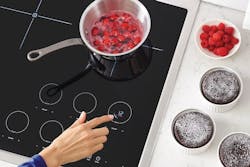Induction: The Coolest Way to Get Things Hot
Induction cooktops and ranges are faster at cooking, safer to use, easier to clean, more energy efficient, and better for the environment than conventional gas or electric cooking systems. Why isn't everyone cooking with induction? Probably because they don't know about it and how it works.
How Does an Induction Cooktop Work?
Induction cooking uses electricity, but in a very different way than the usual electric heating element. The induction cooktop is a glass ceramic surface that does not heat up. Instead, the heat is created in the metal of the cooking pot or frying pan, using the relationship between electricity and magnetism.
Wherever electricity flows, it creates a magnetic field perpendicular to it. This field has energy. It's the force that drives all electric motors.
The effect works in the other direction, too: pass a magnet back and forth next to a piece of conductive metal (like a wire) and an electrical current will flow in the metal. Again, a large quantity of energy can be moved around this way. It's how electrical generators deliver all of the power we plug into daily.
An induction cooker has electromagnets under the cooking surface. A pot or pan made of a magnetic metal (iron, and many types of stainless steel) can be affected by the electromagnets. When the magnets are pulsed on and off, little bursts of electrical current (called eddy currents) are generated in the metal of the pot. They don't go anywhere, because resistance in the metal stops them, and changes their energy into heat.
The pot gets hot, and transfers that heat to the food in it. The induction cooking surface does not get hot. All the heating happens in the pot itself.
Advantages of Using Induction for Cooking
Induction cooking is faster and more responsive than gas or conventional electric cooktops, bringing water to a boil in less than 2 minutes. It's also more energy-efficient. The U.S. Department of Energy measured induction cooking at 84% efficiency—that is 84% of the energy consumed actually gets used to cook. It's not wasted heating up the cooktop, or the kitchen. Conventional electric cooking is only 74% efficient, and gas only 40%.
Because the cooking surface doesn't heat up, it's safer to use. It's also easier to clean: spilled food doesn't get burned onto it.
Cookware for induction cooking has to be made—at least partly—of a magnetic metal. Most stainless steel and cast iron cookware is compatible. Conventional aluminum, copper, or glass cookware won't work. However, specially-made induction-friendly cookware is available that combines layers of different metals to get the advantages of each. For example, a magnetic metal layer, compatible with induction cooking, is fused to a core of very heat-conductive aluminum, which spreads the heat evenly through the pot. An easy rule of thumb: if a magnet sticks to the bottom of the cookware, it’s induction-friendly.

